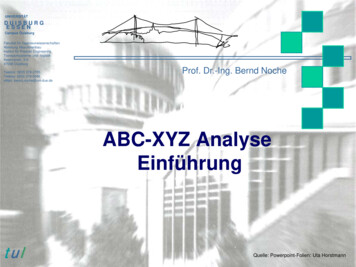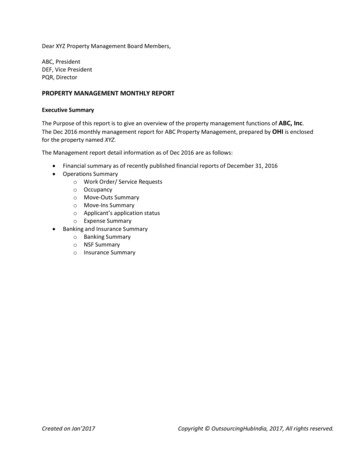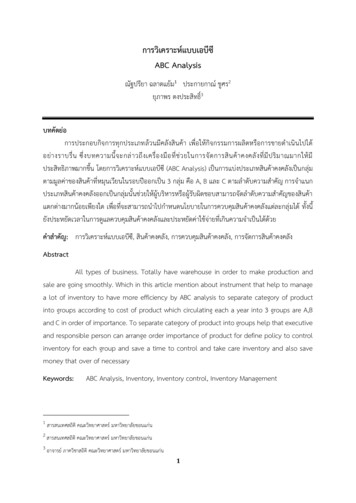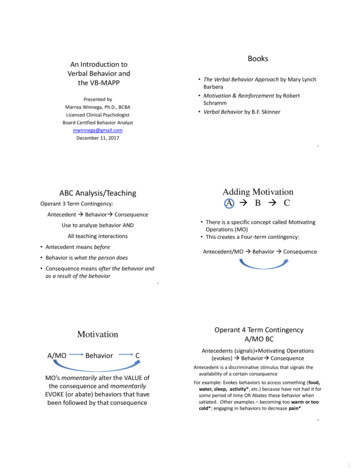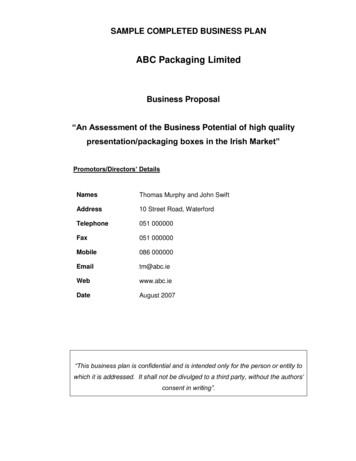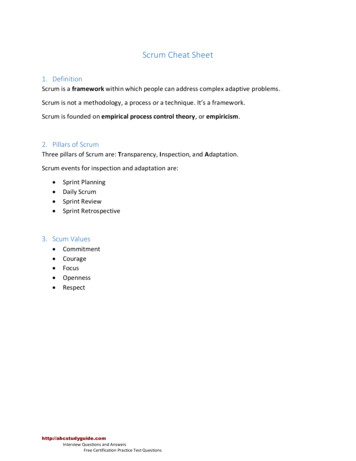
Transcription
UNIVERSITÄTDUISBURGESSENCampus DuisburgFakultät für IngenieurwissenschaftenAbteilung MaschinenbauInstitut für Produkt EngineeringTransportsysteme und -logistikKeetmanstr. 3-947058 DuisburgTelefon: 0203 379-2785Telefax: 0203 379-3048eMail: bernd.noche@uni-due.deProf. Dr.-Ing. Bernd NocheABC-/XYZ AnalysisIntroductiontulQuelle: Powerpoint-Folien: Uta Horstmann
ABC-Analysis2M0000A short definition of ABC-AnalysisThe ABC-Analysis represents a simple methodof material classification in respect of value andquantity. (G. Wöhe)Expressed in a more general way it is a process in order to identfyimportant kinds of customers, suppliers or articles.
3ABC-AnalysisM0000The Pareto principleThe so called Pareto principle indicates that for many phenomenons thefollowing is valid:80 % of effects are reached by 20 % of causes.The principle traces back to Vilfredo Pareto (Italian economist) who, related toItaly, had noticed that 80 % of property belonged to 20 % of the Italianpopulation.Vilfredo Federico DamasoPareto1848 - 1923
4ABC-AnalysisM0000However, the rule often is misunderstood:It seems that 80 % 20 % 100 %.But it can also be valid that:80 % of effects are traced back to 10 % of causes.The principle can also be applied recursively, and not only used for 20% of thereasons :e.g. 64-4 Rule:96-36 Rule:64-4 Rule:51,2-0,8 Rule:e. g. (80 – 16) % (20 – 16)%e. g. (80 16) % (20 16)%e. g. from (80 80/100)% - (20 20/100)%e. g. from (80 80 80/10000)% - (20 20 20/10000)%Source: Wikipedia
5ABC-AnalysisM0000ABC classificationCumulatedValue percentage100orPercentage share 90of sales807060C50B403020A101020304050607080Cumulated proportion(percentage)90100
6ABC-AnalysisM0000ABC classificationExample of values:A GoodsHigh value or share of sales percentage,low proportionB GoodsValueProportionca. 80%(70-80%)ca. 10%(gering)ca. 15%(15-20%)ca. 20%(10-40%)ca. 5%(5-10%)ca. 70%( 40%)Intermediate materialsC GoodsLow value or share of sales percentage,high proportion
7ABC-AnalysisM0000Goals of the ABC AnalysisSeparation betweenessential and non-essentialIdentification of startingpoints for improvementAvoidance of uneconomical efforts
8ABC-AnalysisM0000Measures for A goodsDisposalStock avoiding inventory managementExact determination of (low) safety stock Order basedinstead of consumption based management by valuepercentages.Consumption based management by high salespercentages.Order processingIntensive price negotiationsQualification of alternative suppliersFast invoice cycle in order to secure cash discountperiods.InventoryPermanent inventory
9ABC-AnalysisM0000Different kinds of handling of M types regardingA partC part Purchase market researchGlobal Sourcinge-procurement Value analysisnecessarilynot necessary Assessment of demanddeterministicstochastic Stock-takingpermanentOnce a year Safety stocksmallbig Order cyclehigh -JITgreater cycles
10ABC-AnalysisM0000Analysis example:MaterialYearlydemand(in piece)Costs(per piecein Euro)Contribution to totalcosts (inthousandEuro)Relativecontribution tototal costsCumulatedcontributionto totalcostsClassificationRelativecontribution 000100.000100%100%12456
ABC-Analysis11M0000ABC Analysis procedure1. Determination of absolute total costsAbsolute total costs yearly demand * piece price2. Determination of relative proportions of the total costsRelative proportion of total costs absolute total costs / total costs3. Sorting according to relative contribution to total costs(in descending order)4. Accumulation of relative contributions to total costs5. Classification of materials into three categoriesAccumulation of individual relative total costs6. Determination of relative quantity proportionsRelative quantity proportion yearly demand/ total demand7. Summation of relative quantity proportions per material class
12ABC-AnalysisM0000Analysis example – based on valueMaterialYearlydemand(in piece)Costs(per piecein Euro)Contributionto total costs(in thousandEuro)Relativecontribution tototal costsRelativecontribution toquantitypercentageCumulativecontributionto 02%40%100%CSum1.000.000100.000100%100%100%75%CA
13ABC-AnalysisM0000Analysis example – based on quantityMaterialYearlydemand(in piece)Costs(per piecein Euro)Contributionto total costs(in thousandEuro)Relativecontribution tototal costsRelativecontribution toquantitypercentageCumulativevalue tototal %40%ASum1.000.000100.000100%100%100%100%AC
14ABC-AnalysisM0000Different ABC analysesCriterionReasonsStock valueAmount of capital lockup;Stock reduction potentialQuantity of consumptionOrder picking; Warehouse organisation;storage strategiesTurnover ratioSales volume ; Assignment inwarehouseVolume of salesAmounts of coverage; Selection ofscheduling methodsService levelSafety stock; customer satisfactionReference volume of suppliersSupplier selectionAmount of demandMaterial requirements planning; Salesvolume
15ABC-AnalysisM0000Fields of applicationRangePurchasingCharacterKey figureMaterial / MaterialgroupsPurchasing volumeSupplierInvoice amountProductSalesSales organizationIncoming ordersClients / Client groupsSalesSales areaSalesSupplierDefective productsMaterialAccess frequencySalesMarketingQuality managementInventory management
ABC-Analysis16M0000Criticism on the methodology of ABC AnalysisThe classification into only three categories us very rough.The determination of limiting values is based on empiricalvalues and is thus random.The ABC Analysis offers only a figure of the currentactual situation.
17ABC-AnalysisM0000SummaryCharacteristics of the ABC Analysis General classification of characteristic values in respect of the importancewith certain operating figures.Concentration by the following trisection:Aimportantpremiumtop-sellingBless importantmedianaverage levels ofturnoverCRelativelyunimportantlow-valuenarrow marketAdvantages of the ABC Analysis Analysis of complex problems with justifiable effort (by focussing on theessential factors)Simple application (in many fields)Very clear and graphical presentation of the results
18ABC-AnalysisM0000XYZ AnalysisCategory ConsumptionXconstant, fluctuations rarelyYWilder fluctuations, often for reasonsof trend or seasonal reasonsZCompletely unsteadyAbility toscheduleHighMiddleThe ABC Analysis is often combined with a XYZ Analysis.Low
19ABC-AnalysisM0000Disposal process with a combination of ABC and XYZAnalysisClassification of conductor platesaccording to ABC/XYZ AnalysisXYZ ABC 40322742832420101011114250135227Recommended Disposal processes(Source: Österreichisches Schulportal des Bildungsministeriums)
20ABC-AnalysisM0000Determination of scheduling guide linesDelivery of componentsfrom the inventoy bufferof the suppliersynchronous toproductionInventory buffer at theproduction siteImplementation of a supplierkanban by using a logisticsservice providerQuelle: RWTH Aachen
21ABC-AnalysisM0000Classification of parts for die program andstock cB-Partsorder operated Date and lotsize depend on current,deterministically identified demandconsumption-driven Lotsize is fixed Dates according to consumption ofpartsC-PartsCharakterization Date and lotsize are fixed low fluctuations in demand
22ABC-Analysis AX good can be planned in more detail than CZgoods XABRRhigh value percentagecontinuous demandhigh predictive valueRYaverage value percentagecontinuous demandhigh predictive valuelow value percentagecontinuous demandhigh predictive valueaverage value percentagefluctuating demandaverage predictive valuelow value percentagefluctuating demandaverage predictive valueChigh value percentagefluctuating demandaverage predictive valueCZChigh value percentageirregular demandlow predictive valueCaverage value percentageirregular demandlow predictive valuelow value percentageirregular demandlow predictive value{Potential for Rationalization Control complexity }M0000
23ABC-AnalysisM0000The material portfolio„Relevance for the result“vs.„Exercise risk“highStrategicalmaterialHandle materialProvision principlesRelevanceforthe resultNoncriticallowBottleneckmaterialExercise riskhigh Strategical materialBottleneck materialHandle materialNoncritical materialQuelle: „Grundzüge der Beschaffung, Produktion und Logistik“, Pearson Studium
ABC-Analysis24M0000The material portfolio Strategical material:close oberservation and exact forecasts, long-term supplierrelations, joint projects Bottleneck material:additionally more suppliers or other material Handle material:intensive discussions about price, order size optimization Noncritical material:rough planning, stockpiling, standardization,reduction of suppliers
25ABC-AnalysisM0000Program-oriented determination of demandArticle code 10 Description: gear boxPieceParts lists:Article codeDescriptionDragUpper part completeParts lists according toBack gear completeAxle drive shaft completeamountParts lists according tostructureModular parts listsScrewAxle drive shaft completeAxle completeCenter boxbearingbearingAxleSplined keyScrewAxleGear wheelGear wheelCopeGear wheelGear wheelQuelle: „Grundzüge der Beschaffung, Produktion und Logistik“, Pearson Studium
ABC-Analysis26M0000GozintographThe Gozintograph is a directed graph whichdescribes what parts make up one or moreproducts. Thereby, the production process canbe multi-level, whereas the input consists of rawmaterials, semi-finished and finished parts. Inthe Gozintograph is listed how these parts arequantitatively linked. Thereby, the knots describethe parts and the directed edges specify howmany units of a part incorporate into a unit of adownstream part. (Wikipedia)Quelle: „Grundzüge der Beschaffung, Produktion und Logistik“, Pearson Studium
27ABC-AnalysisM0000JIT as a total conceptObjective: „Elimination of the enduring waste and delayat each step from the raw material to the end customer “i.e. not only a production synchronous procurement, but also:Minimization of waiting time (Zero Lead Times)Minimization of workin time requirement (Zero Handling)Minimization of set-up times (Zero Set-Up)Minimal lot sizes (Zero Lot Size)Minimization of Quality defects (Zero Defects)Minimization of fluctuations in production (Zero Surging)Quickest troubleshooting and preventive maintenance (Zero Breakdown)Quelle: Prof. Dr.-Ing. W. Ullmann
ABC-Analysis28M0000JIT logisticsObjective of the JIT logistics is to guarantee a maximum added value inmanufacturing processes:Minimal material coverages at the place of consumption (max. 120 min)Frequent delivery (picking at a high variety)Removal-compatible provision, Tendency to special carriers,Avoidance of packing materialMinimal number of handling steps, ideally „ship-to-line“ without receiving storagelocation; placed on the line directly from the supplierRoute controlled delivery according to schedule, use of logistics hauls instead offorklifts (bus instead of taxi principle)Use of Material providers for the constand distribution, maybe separation ofmaterialSelf-controlled Kanban control loops for continuous consumptions
ABC-Analysis29M0000JIT logistics (cont.)Trustful partnersip between supplier and consumer because of theincreased uncertainty of the supply due to inventory reduction,Common continuous improvements in the collaboration betweenpartners,Reduction of the number of suppliers („single sourcing“) due to highhandling costs,The short-term nature of delivery schedules requires a high flexibility of the supplier,Production without inventory is only possible when the configuraton of the singledelivery schedules occurs with the highest degree of accuracy,Zero defects quality („100% good parts“),Integration of efficient logistics service providers,Integrative, economic levels spanning information supply.
30ABC-AnalysisM0000JIT logisticsSynchronous processes insingle piece flow reduceinventories!Highly frequent materials handlingin small quantities :Small load carrier replace bulk containersLogistics hauls replace forklifts(Bus instead of taxi-principle)
ABC-Analysis31M0000The origin of the KANBAN systemThe beginnings of the KANBAN system go back to the fifties of this century.Reasons (Raumknappheit, Kapitalmangel) forced the enterprisers (espciallyin Japan) to particular strains to reduce their inventories and den to rationalizethe material flow withing the production area and also between the plants.From this rethinking the Just-in-time principle (JIT) was developed and theKANBAN system as a particular form of realization.This system can not only be transferred to the area of purchase andstockkeeping, but it can also be used as a simple self-regulatingmanufacturing control.
32ABC-AnalysisM0000Objectives of the KANBAN systemA KANBAN system is essentially characterized by a lowamount of control installation and beyond that it pursues the following logisticsobjectives :Reduction of material stocksReduction of lead timesIncrease of transparency of the operational processIncrease of working productivityIncrease of flexibility regarding the short-term willingness tosupplyIncrease of quality control
ABC-Analysis33M0000Functionality of the KANBAN systemThe most important elements of the KANBAN system are:Division of production in a system of meshed, self-regulated control circuits,consisting of each with a parts concsuming area (sink) and the belongingupstream parts producing area (source).Setup of an intermediate bearing (buffer) between parts consuming and partsproducing area in order t
ABC-Analysis 11 ABC Analysis procedure 1. Determination of absolute total costs Absolute total costs yearly demand * piece price 2. Determination of relative proportions of the total costs Relative proportion of total costs absolute total costs / total costs 3. Sorting according to
